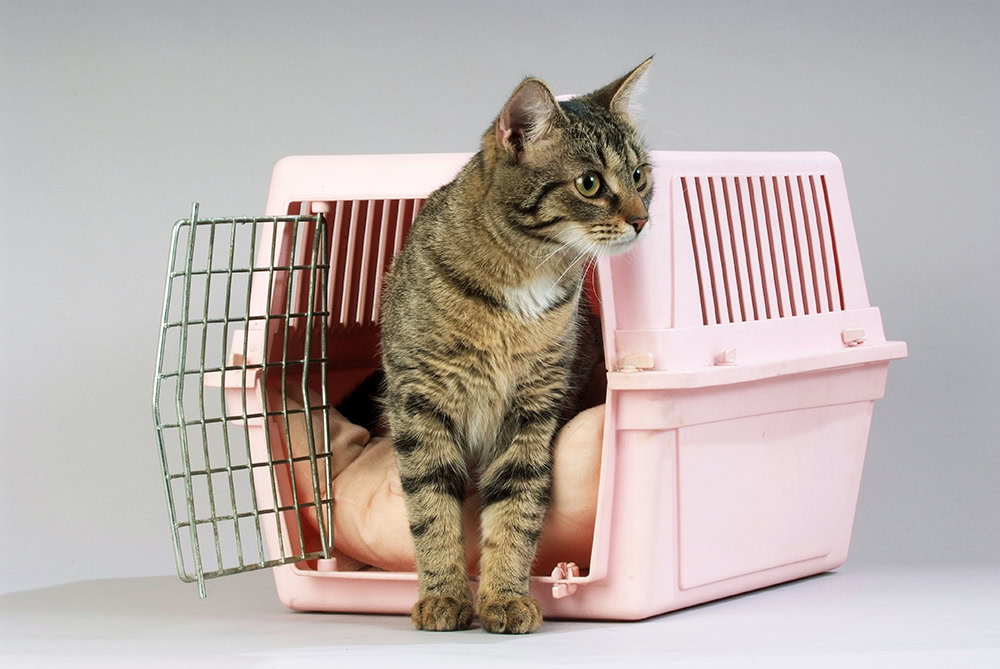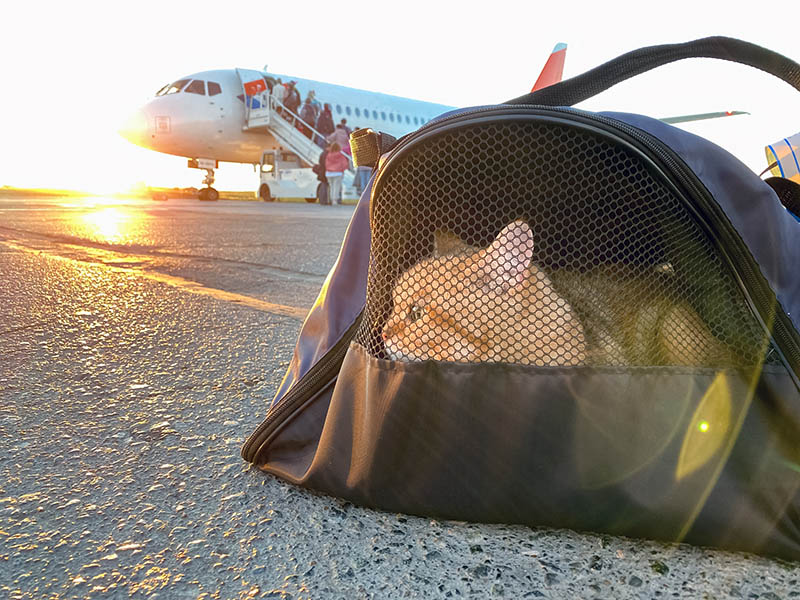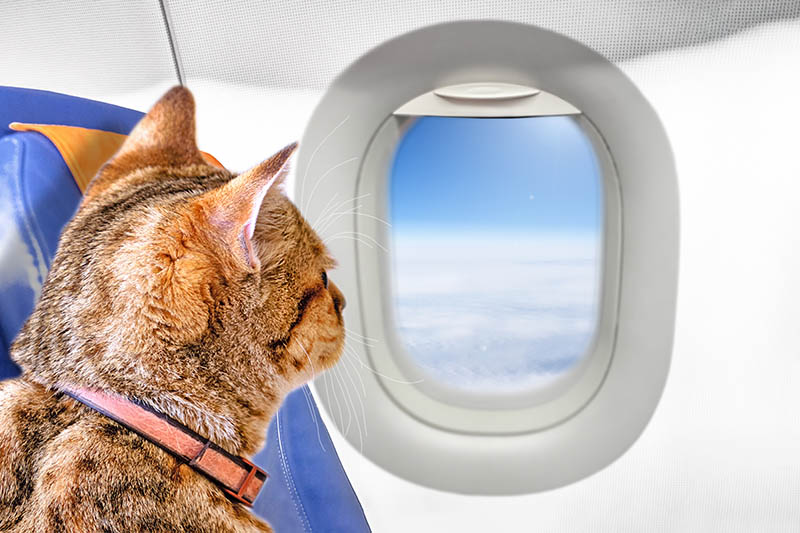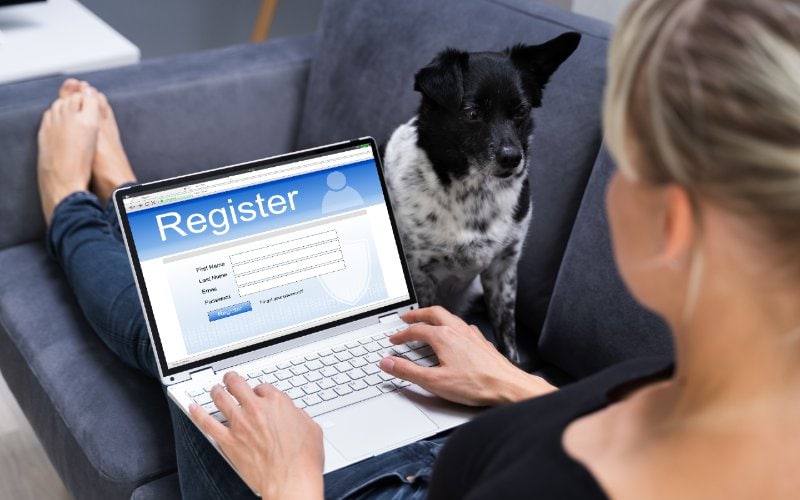VET APPROVED

The information is current and up-to-date in accordance with the latest veterinarian research.
Learn more »Click to Skip Ahead
Traveling is stressful enough, but it can be positively anxiety-ridden when you’re bringing your cat with you. The idea of confining your cat in a carrier for hours and how frightened they might be throughout the entire ordeal can give you second thoughts.
Also, how on earth will your cat be able to use a litter box while in midair? There are certain steps that you can take, such as using absorbent puppy pads. However, it ultimately depends on the airline’s policies and the particularities of the trip. In case of pets traveling in the cabin, they will need to stay in their carrier for the whole duration of the flight.
How your cat is allowed to travel on a plane will also greatly depend on their breed and size, which will dictate in which manner they can travel on a plane, whether it’s a short flight, they’re a brachycephalic breed and they are allowed to travel in the cabin if under a certain weight limit, or it’s a longer across-the-ocean flight, and they may be traveling in a large crate in the pet cargo section.
Let’s discuss how to handle your cat while on the plane and how to plan for the trip before you leave.

Bringing Your Cat on a Plane
It should be noted that most adult healthy cats can go as long as 24 hours without using the litter box.1 But it isn’t recommended that you make a cat wait past 24 hours, as this can lead to serious health problems.
That said, how you handle your cat’s litter box while flying depends on the airline, the duration of the flight, the number of transfers and your preferences.
In the Cabin
Most major airlines allow cats in the cabin with you, but there are certain rules to follow, including the weight and size of the carrier.
The carrier also needs to be airplane-approved, so even before booking your ticket, you should speak to someone at the airline about their requirements for bringing your cat with you. Additionally, your cat must stay in the carrier during the entire flight.
In the Cargo Hold
The other option is having your cat placed in the cargo hold. One advantage is that there are no restrictions on the size of the carrier, so they can have more room to move around. You can even place a small litter box inside the carrier, which ideally should be fixed in place, so it doesn’t move around or injure your kitty in case of turbulence.
That said, cargo holds sound scary to many cat owners, and there are many factors that need to be taken into account, such as the animal’s breed, health, age, size, and temperament .2 The sounds, smells, and sights can be frightening to pets, and unfortunately, while it isn’t common, some animals have died while in cargo.

How a Cat Goes to the Bathroom on a Plane
One way to deal with the bathroom issue, particularly if you’re on a long flight, is to use pee pads, typically used while training puppies. Most brands can hold up to about 3 cups of liquid! You can also consider using a cat diaper—if your cat’s dignity allows it.
You can bring a portable litter box or make your own, such as cutting a shoe box to 2 inches in height. Carry a baggy with cat litter, and encourage your cat to use the litter box before boarding.
Bear in mind that most airlines will not let you take your cat out of the carrier while on a flight, so you will most likely need to rely on pee pads or a diaper, and clean everything up when you’re off the plane.

The 5 Tips How to Plan a Trip With a Cat in Tow
Before booking anything, consider if you can drive to your destination rather than fly. It’s a highly stressful event even for the bravest of cats, and they are likely able to handle a long drive better. But if this isn’t possible, you’ll need to look for the right airline-approved carrier.
1. Cat Carrier
Check with the airline that you’ll be flying with before purchasing a new cat carrier. They will let you know the acceptable dimensions. Some manufacturers will list the airlines that accept their carriers, but always double-check before purchasing.
Some carriers come with food and water bowls that can attach to them, which are great features. Still, you might not find too many options for the small carriers that are accepted in the cabin. You can opt instead to get collapsible food and water bowls to give your cat before and after the flight.
Understand that if your cat comes into the cabin with you, they are considered a carry-on. You’ll also need to pay a fee for bringing your pet on board, and the carrier must fit under the seat in front of you.
At least a week before your trip, you should leave out the carrier and open it so your cat can explore and even get cozy inside of it. Place their favorite toys, catnip, and treats inside in addition to any cozy blankets—even better if they smell like you and/or your cat! This way, you’re building a positive association between your cat and the carrier that they will be spending a long time in. Make sure the carrier is sturdy and doesn’t have any faults, causing it to malfunction or open and your pet to escape.

2. Veterinarian Check
Most airlines require proof of vaccinations and health certificates, so you’ll need to have an appointment before traveling. This is particularly important if your cat has a health condition. Your vet can also give you advice on making the trip more comfortable for your cat.
While you’re there, seriously consider having your cat microchipped if they aren’t already. If the unthinkable occurs and your cat escapes, you have a much better chance of having them returned to you.
3. Breed Restrictions
Some airlines have restrictions on pets, including cats that are pregnant, senior, or 2 months or younger or have a serious health condition.
Some breeds are also subject to restrictions, specifically flat-faced cats, also known as brachycephalic breeds,3 which include Persians, Exotic Shorthairs, and Himalayans. These breeds commonly have respiratory problems or are more prone to them, so if you have one of these cats, check with the airlines about their restrictions.

4. Harness and Leash
This is a good idea if you often travel with your cat. Having a harness on your cat can help you keep your cat secure, particularly when you need to take them out of the carrier when going through security.
If they haven’t worn a harness before, get them used to it well ahead of the trip. Pick one that fits your cat snugly but isn’t too tight, and start putting it on them at home daily, at least a few weeks before your trip.
5. No Meals
On the morning of the flight, only give your cat water; don’t feed them unless they must eat for medical reasons. This is to prevent them from vomiting or having diarrhea while on the plane.
You can bring cat food with you, but your cat will likely not be interested in eating until you reach your destination.


Conclusion
Sometimes we have no choice but to fly with our cats. With the right preparation, you can make the trip as smooth as possible, and you and your cat should arrive relatively unscathed.
If your flight is fairly short, chances are that you won’t have to worry about your cat needing to go to the bathroom. But if your flight is a long one, you’ll definitely want to be prepared.
Ensure that you have baggies and disposable gloves with you. Supplied with pee pads and/or diapers, your cat should be as comfortable as they can be, given the circumstances.
Featured Image Credit: vaalaa, Shutterstock











